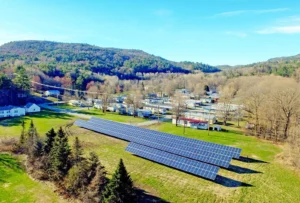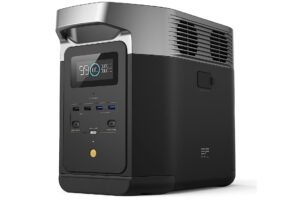New Hampshire seeks IRA grant to help low-income residents tap the benefits of solar


This solar project at the Mascoma Meadows manufactured home cooperative in Lebanon, New Hampshire is an example of the type of project that could get a boost from federal funding. (Credit: Revision Energy)
by Sarah Shemkus, Energy News Network
New Hampshire’s Department of Energy has requested a $70 million federal grant to expand community solar programs for low-income residents, an infusion of funds that supporters said could lower energy bills, accelerate decarbonization, and perhaps even catalyze the development of much-needed affordable housing.
“It’s just going to be life-changing for the communities we do this with,” said Jeannie Oliver, a senior director at the New Hampshire Community Loan Fund, which partnered with the state on the proposal.
The request is part of the Environmental Protection Agency’s Solar for All competitive grant program, created under the umbrella of the 2022 Inflation Reduction Act. The goal of the $7 billion program is to increase access to solar for people living in low-income and disadvantaged communities. Up to 60 grants will be awarded.
Community solar is a model in which energy consumers own a stake in or subscribe to a share of output from a solar development. They then receive credits for a portion of the power sold back to the grid, offsetting their utility bill. Community solar is often considered an option for consumers who can’t or don’t want to install solar on their own home, but who still want to participate in the environmental or financial benefits of renewable energy.
GO DEEPER: Renewable Properties founder and president Aaron Halimi joined Episode 33 of the Factor This! podcast to discuss the future of community solar in California which, to date, has lagged behind other markets, despite the state’s role as a leader of the energy transition. Subscribe wherever you get your podcasts.
New Hampshire authorized community solar in 2013, but it hasn’t gotten much traction. In the state, larger, non-municipal solar projects are only credited for generation on projects up to 1 megawatt in capacity. At that size, however, the finances just don’t work for developers, said Sam Evans-Brown, executive director of the nonprofit Clean Energy New Hampshire. It’s not until an array reaches around 3 megawatts – with net metering – that the economics start to make sense.
Reaching lower-income residents with community solar is even trickier. There are no easily available lists of what households qualify as low or moderate income, so acquiring customers can be prohibitively difficult.
An influx of federal money could change that equation. The grant money would be used to expand the existing program and to create new ones targeting affordable housing and resident-owned manufactured housing communities. The proposal calls for funding to be split between the state energy department, the New Hampshire Community Loan Fund, and New Hampshire Housing.
‘Meeting people where they are’
If the grant is awarded, these partnerships will be key to maximizing the impact the funds can have on low- and moderate-income residents, said Joshua Elliott, director of the division of policy and programs at the New Hampshire Department of Energy.
“It made sense to leverage existing relationships,” he said. “We thought meeting people where they are rather than having them come to us whenever possible would make for an attractive proposal.”
The portion of the money going to the state energy department would be used to expand the existing program for low-to-moderate-income community solar. The program will fund some of the project if a majority of the power generated benefits low-income households and up to 100% of a new development if at least 80% of the participating households qualify as low-income.
The state program has awarded $1 million each of the last two years. Last year, it funded four developments with a total of 61 households participating. More money could help both by funding more projects, and making it easier for potential developers to plan, Elliott said.
“Having additional funding available consistently helps these organizations as they are trying to sketch out a project and figure out if it works,” Elliott said.
The Community Loan Fund’s portion would be used to help resident-owned manufactured home communities build solar arrays to service residents. A resident-owned community is a manufactured home park in which the residents have come together as in a cooperative to buy the land on which their homes sit, creating for themselves a more stable housing future.
The community loan fund has been working on developing community solar with these groups since 2018 when it led the creation of an array in the western New Hampshire city of Lebanon. Today, they have four projects either in operation or under construction.
“The reason that has been slow is that the financial barriers to low income solar are pretty immense,” said Oliver, who leads the organization’s resident-owned communities program. “What the Solar for All program would do is really help us scale up.”
The remaining money would flow through New Hampshire Housing, a public corporation that promotes housing affordability and access throughout the state. It already works closely with the state’s 18 public housing authorities, so it has relationships and experience with the low-income population the funded programs would be targeting.
‘Giving landlords a carrot’
Much of the New Hampshire Housing money would be used to connect renters in multifamily buildings with community solar.
Traditionally, bringing solar to renters has been difficult because of what is often called the split incentive – if tenants pay their own electricity bills, landlords have little motivation to spend money on solar panels when the renters will reap the financial benefits. The grant proposal would encourage landlords to take over tenants’ utility bills, and roll the cost into the rent, reflecting the discounts community solar would create.
“The Solar for All proposal takes a huge step in moving things in a more positive direction,” Evans-Brown said. “It’s giving landlords a carrot to figure this out.”
The EPA should be announcing the grant recipients in March 2024 and distributing the funds in July, Evans-Brown said. Solar projects using the money should start popping up by 2025.
If New Hampshire receives the grant, it could be transformative, supporters said, by both accelerating the state’s decarbonization efforts and making a significant difference for financially struggling households. In concert with other federal programs pouring money into home electrification and energy efficiency, the Solar for All funds could jumpstart significant and much-needed growth in green housing development, Evans-Brown said.
“The thing I am excited about is this influx of money is going to result in a large amount of multifamily, sustainable housing getting built that’s going to be really affordable,” Evans-Brown said. “I am really optimistic.”
This article first appeared on Energy News Network and is republished here under a Creative Commons license.![]()




